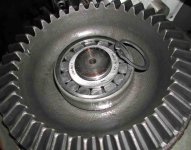dfkrug
Super Member
- Joined
- Feb 3, 2004
- Messages
- 7,706
- Location
- Santa Cruz Mtns, CA
- Tractor
- 05 Kioti CK30HST w/ Prairie Dog backhoe, XN08 mini-X
Be forewarned, the following has not been tested in this specific application in any way. Just "thinking out loud"
After reading through SKF's bearing book, I would say that their NUP208ECP and NUP209ECP roller bearings could possibly be a suitable replacement for the 6208 and 6209 ball bearings.
This is exactly the failure and the solution to failed fork bearings in my old Kawasaki street bike. The ball bearings failed, and roller bearings that had the same dimensions solved the problem. It was so common, the maker eventually went roller. Duh.
